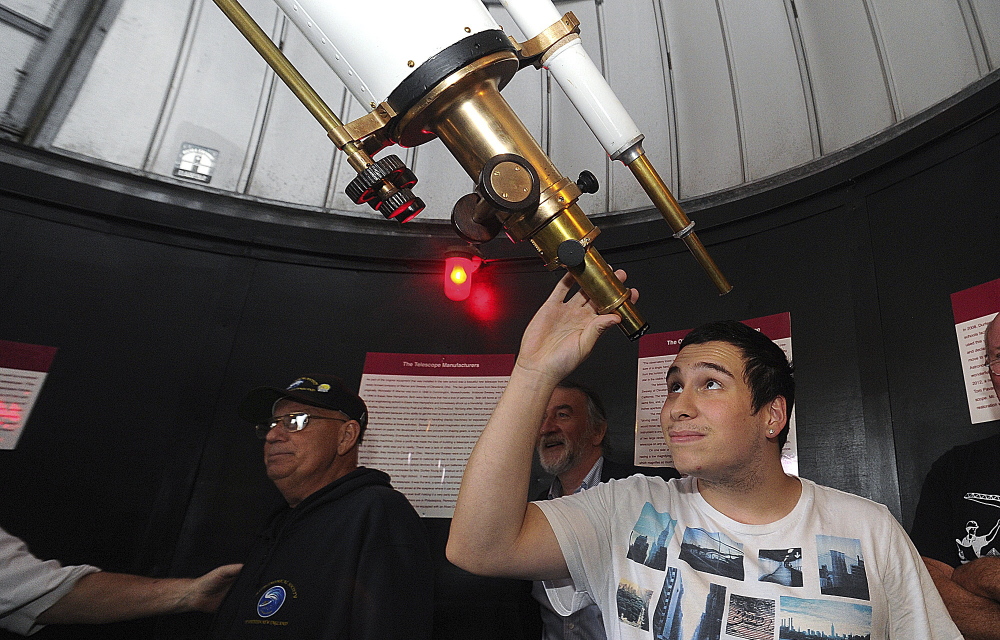FALL RIVER, Mass. — After decades of lying idle, B.M.C. Durfee High School’s 127-year-old telescope is once again pointing at the stars.
Now it just needs some curious eyes to peer through its lenses.
School officials, local astronomy enthusiasts, teachers and students joined together late last month to dedicate the recently restored telescope. It is now housed on Durfee’s rooftop in a dome that also has been restored, by students.
Unfortunately, the weather was cloudy and drizzly, not great for showing off the celestial gazing capabilities of the rare 4-foot-long telescope with an 8-inch lens that was built in 1887 by the long-closed Cleveland-based company Warner & Swasey.
But that didn’t stop folks from recognizing and marveling at their accomplishments, a telescope whose white body and brass parts shined as it was mounted on a large stand via a mechanical pivot with spinning gears and cranks.
The effort to restore it began in 2009. But it didn’t begin in earnest until about two years ago, said Tom Pavao, a retired Durfee career counselor who was one of the driving forces behind the project.
By then, the telescope had been dismantled, and its lenses sat for a few years in the living room of Fall River resident Bettina Briggs, whose younger brother, John, had inspected them to see if they had been cracked. Bettina Briggs essentially had become custodian of the lenses.
“Turns out they needed cleaning, but they were not destroyed,” she said.
Pavao soon contacted the Astronomical Society of Southern New England. Jerry Trahan, a retiree, and fellow members of the society took on the project and volunteered to work on the telescope.
Trahan explained why: It was a rarity.
“This was one of the first seven telescopes that Warner & Swasey ever made. This is the only one to have an Alvan Clark lens,” Trahan said.
“They polished, painted, greased, everything they had to do, and put it together,” Pavao said.
“Everything seemed to work properly.”
Everything except for the clock mechanism on which it rests. It counters the earth’s rotation and enables the telescope to stay fixated on an object.
That was the most expensive part.
David Gow, a conservationist for the Willard House & Clock Museum in Grafton, completed it.
“It was decrepit. The teeth were all stripped,” Gow said, describing the former condition of the clock wheel, meaning it couldn’t engage the rotating pinions. And some of the steel components were severely corroded.
So Gow made a completely new brass wheel with new teeth to catch the pinions.
“One of the main things to remember in conservation is do no harm,” Gow said. “In some cases it’s better to make a new piece rather than repairing the original.”
Looking at the finished telescope on Thursday, Gow said, “Wow, this is beautiful.”
Twelve students from Durfee’s construction craft program completed the restoration of the rooftop dome. Graphics communications students created signs that have been hung on the dome’s wall explaining the telescope’s history.
Colton Botelho, a senior in the construction program, said he was proud to have worked on the project because its history is aligned to his family’s history.
Botelho said his grandfather had used the telescope when he was a Durfee student and president of its astronomy club.
“Something like this doesn’t happen by accident,” Durfee Principal Paul Marshall said of the restoration. “It happens because we’ve got people who are passionate about what they do. And I’ve never seen people more interested and more engaged in the work.”
In all, the project cost around $3,200, but it could have cost a lot more, Pavao said.
“For the time when it was made it was a pretty powerful telescope. We do have a historical piece,” Pavao said.
Copy the Story LinkSend questions/comments to the editors.



Success. Please wait for the page to reload. If the page does not reload within 5 seconds, please refresh the page.
Enter your email and password to access comments.
Hi, to comment on stories you must . This profile is in addition to your subscription and website login.
Already have a commenting profile? .
Invalid username/password.
Please check your email to confirm and complete your registration.
Only subscribers are eligible to post comments. Please subscribe or login first for digital access. Here’s why.
Use the form below to reset your password. When you've submitted your account email, we will send an email with a reset code.